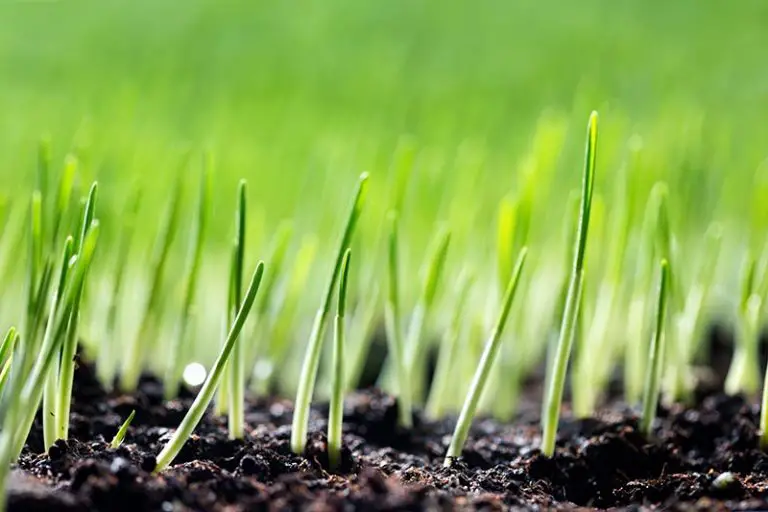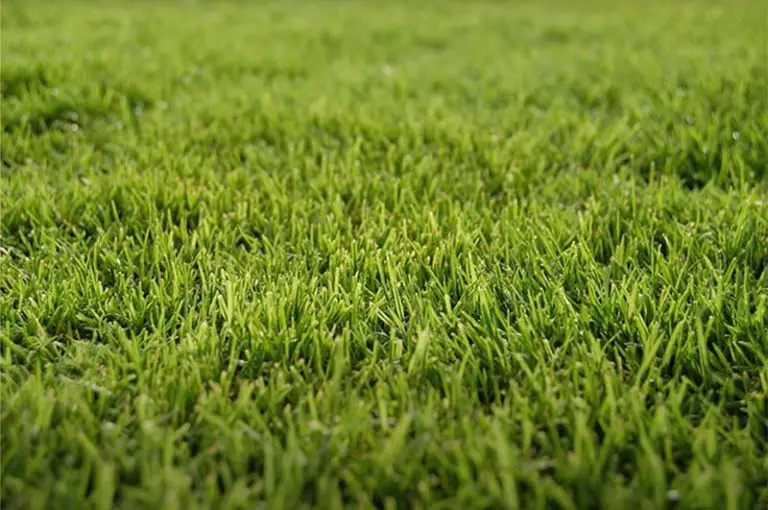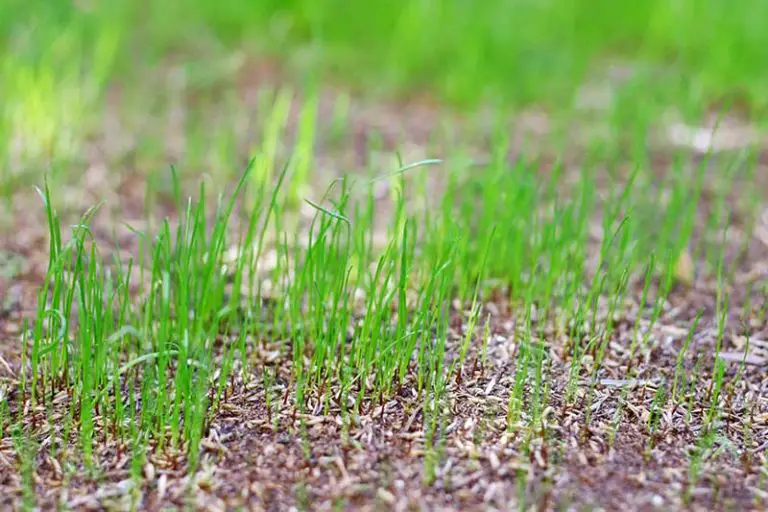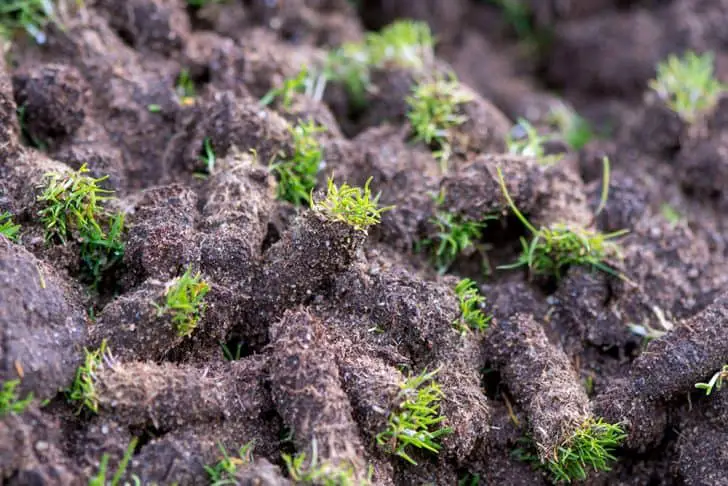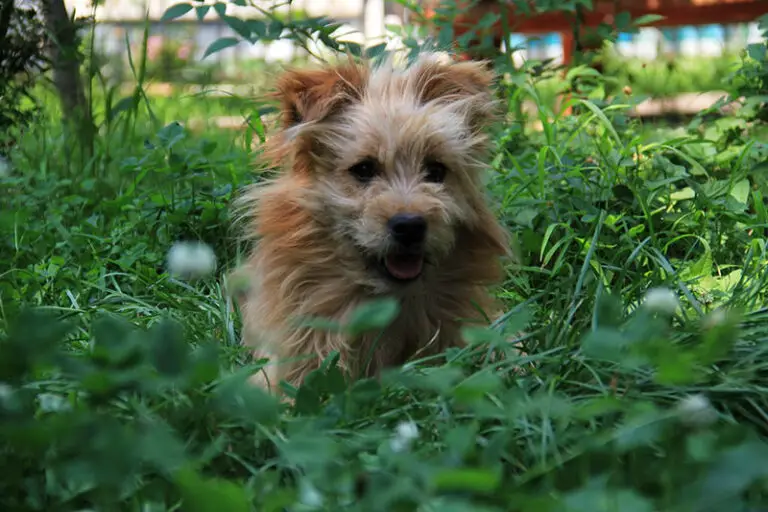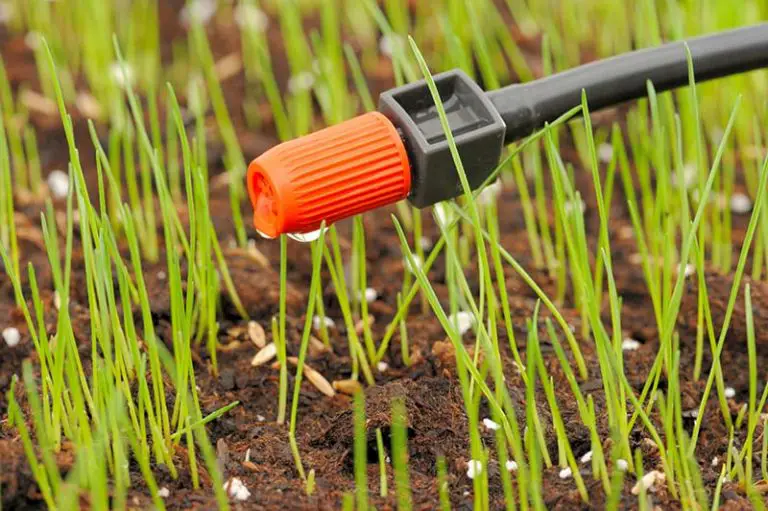Protect Your Grass Seed: How to Keep Birds Away
Birds are an essential part of the ecosystem, playing a key role in maintaining the natural balance of the wildlife in your yard. With that said, birds aren’t always the most welcome guests when trying to grow a new lawn from grass seed. All it takes is one hungry flock to spot your newly seeded lawn, and within hours, they’ll have feasted on your hard work.
There are several different methods you can use to keep birds from eating grass seed; these include using particular birdproof planting methods, using a ground cover to keep the birds off the seeded lawn, and using bird deterrents to guide the birds away from your yard. These methods are most effective to keep birds away when used in conjunction with each other.
Do Birds Eat Grass Seed?
Birds do eat grass seed, as they are what’s known as granivorous animals. For many species, such as sparrows, finches, and pigeons, seeds are a vital source of nutrients, vitamins, and minerals. To birds, grass seeds taste great and are easy to eat. This makes a newly seeded lawn look like a buffet to any hungry birds nearby.
It may seem unfriendly to the environment to take away a source of food for birds. However, if planting at the best time for your grass species, it should be some point from spring through to fall; throughout these months, there are plentiful sources of other types of food for the birds like wild seeds and berries. Therefore, you shouldn’t feel guilty about putting in some temporary preventative measures to protect your seeds from these opportunistic creatures.
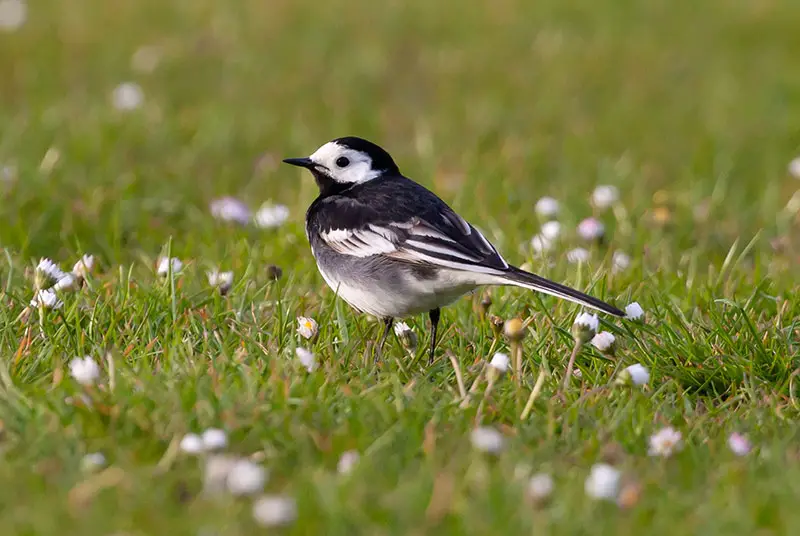
How to Keep Birds From Eating Grass Seed
1. Use Bird-proof Planting Methods
The first set of options to keep birds from eating your grass seed involves different steps of the planting process. From preparing the planting area to the method of seeding you use, there are a few steps you can take during the process to help protect your new seed from birds.
1.1 Remove Bird Food Sources Before Planting Seed
If you’re already dealing with a high number of birds in your yard, it’s most likely because they’re finding a source of food there. This could be from intentional bird feeders, or in pet food bowls for your other animals. Alternatively, it could be a sign that you have an infestation of insects such as grubs, slugs, or mosquitos; these are also all tempting sources of food for birds.
By removing these food sources from your yard, you can give the birds a cue to look elsewhere for food. However, we recommend replacing the food sources after the seeds have sprouted to encourage the birds to return.
Method: Before planting, do everything you can to remove attractive sources of food that may be bringing birds to your yard. If you are already dealing with an unusually high amount of bird activity around your lawn, check for pests first; you may need to treat the area with a pesticide before you attempt to plant your grass seed. At least two weeks before planting, remove any sources of food that may be tempting to birds. Replace the food sources after the seeds have finished germinating.
1.2 Plant Specialist Seeds
There are some types of specialist grass seeds that are particularly beneficial for homeowners trying to keep birds from eating their seed. These include coated bird-repellant seeds and fast absorption seeds.
Bird-Repellant Seeds
Bird-repellant seeds are grass seeds with a coating of a bird repellant substance. While the substance is non-toxic to the birds, it makes the grass seed taste terrible to them. This allows you to put them off eating your grass seed without causing them any actual harm.
Alternatively, you could create a DIY organic bird repellant solution using substances from around your home. For example, some smells and tastes that will deter birds from your grass seed include vinegar, garlic, chili, cayenne pepper, and peppermint oil. Mix any of these substances with water to create a DIY repellant, before applying it to the newly sown seed. Repeat treatments every 3 to 4 days.
Absorption Seeds
Absorption seeds are specially designed grass seeds that promote germination and growth at a much higher rate than regular seeds. They grow around ten times faster than normal seeds by absorbing high amounts of moisture from the soil. Even though this won’t actually deter birds, the fast germination reduces the chances they get to steal the seeds.
The only drawback to absorption seeds is that they are also much more expensive than regular seeds. With that said, it may be worth the extra expense to avoid having to spend more money on seeding multiple times when seeding with regular seeds fails.
1.3 Plant Seeds at Higher Seeding Rate
In addition to being eaten by birds, there’s always the possibility that your seeds will be blown or washed away, or simply rot before they germinate. Planting your seeds at a higher seeding rate will increase the number of seeds on your lawn, thus increasing the number of seeds that germinate overall.
Method: Different seed types will come with different recommended seeding rates, listed on the packaging of your chosen seed. You can refer to this rate to know how much seed you should sow per square foot of your yard. Taking the recommended seeding rate for your chosen seed, multiply it by 0.75 to 0.8 to seed at a 25% to 30% higher rate. This ensures that you compensate for any potential seed loss without overcrowding the planting area, which can also stunt germination.
1.4 Consider Planting Using Hydroseeding
Hydroseeding is a specialized method of planting grass seed that involves spraying the seed onto the planting area using hydroseeding equipment. The hydroseeding mixture is in a liquid format made up of seed, mulch, fertilizer, tackifier, and several other substances that maximize the chances of successful germination. This composition of the hydroseeding mixture helps to protect the seed from being eaten by birds or moved around.
Method: It is possible to carry out the hydroseeding process yourself; however, this is a seeding method that requires more technical skill and experience than hand seeding or laying sod. Unless you have the experience, it’s best to contact a professional team to carry out the hydroseeding process.
1.5 Rake Seeds After Sowing
You should ensure to thoroughly incorporate the seeds into the top layer of soil straight after sowing them. If left sitting on the soil surface, they are too visible and accessible to nearby birds. They are also much more susceptible to being washed or blown away. Raking the seeds after sowing not only helps to prevent these issues, but also improves seed-to-soil contact. In turn, this improves the chances of success with the seeding process overall.
Method: During the seeding process, gently rake the seed into the top layer of soil; rake until the seed is buried in the topsoil to a depth of about ⅛ inches. Next, add a small amount of water to help the seed and soil stick together. This helps to improve germination while making it more difficult for birds to dig the soil and reach the seed.
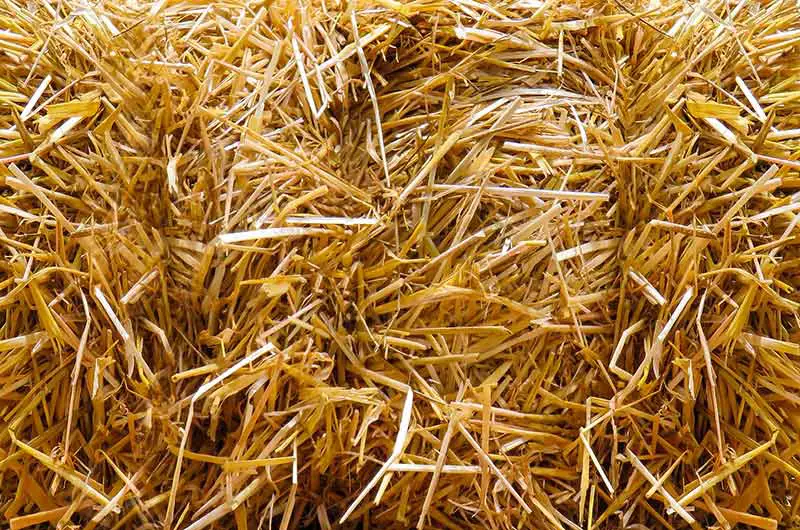
2. Use a Ground Cover
The next set of options you have to birdproof your grass seed is to use a ground cover, such as netting, mulch, compost, or straw. Granivorous birds use their excellent eyesight to spot seeds laying on your lawn; as soon as they catch sight of the seed, they will flock and have a feast on your new lawn. Because of this, one of the best methods to keep birds from eating grass seed is to cover the planting area.
2.1 Cover Grass Seed with Bird Netting
You can cover the planting area with netting to protect your seeds from both birds and the elements. The netting helps to keep seeds in place, while also allowing them enough access to light to germinate and grow. On top of this, you can reuse the netting for other vegetables and crops around your yard once you’re done.
Good quality bird netting is typically made from durable, weather-resistant nylon. It works to prevent birds from feeding on seeds by stopping them from laying their feet on the ground. You can buy more heavy-duty netting if your birds are particularly persistent.
Method: After planting your grass seed, rake the soil lightly, then spread the netting over the planting area. Take some wooden or metal stakes and use them to secure the netting in place; make sure the netting is a few inches above the soil level. If you have small trees or shrubs around the planting area, you can utilize those to fasten your netting in place.
2.2 Cover Grass Seed with Burlap Sheets
Burlap sheets are another type of ground cover you can use to block your grass seed from the view of hungry birds. These are made from natural woven fabrics, and help the soil to retain moisture and maintain a constant temperature. They allow air and light to pass through to the seedlings while acting as a physical and visual barrier to the birds.
Method: Rake the soil after planting your grass seed, then spread the burlap sheets across the planting area. Use u-pin wires, or heavy objects such as stones or bricks to weigh down the sheets at the edges to prevent them from blowing away.
2.3 Cover Grass Seed with Transparent Tarp
If you live in a colder climate and you’re sowing your grass seed later in the year, transparent tarps make an ideal ground cover. These tarps are made from transparent sheets of plastic that create a micro-greenhouse effect; they help the soil retain moisture and warmth while allowing light to pass through to the seedlings.
As transparent tarps are so lightweight, they also allow the grass to grow without putting too much pressure on the tender young blades. However, the biggest downside is that they make watering the seedlings a challenge. Also, they aren’t suitable for use during warm periods; they can cause the soil to retain too much heat, thus ruining the grass seeds’ germination process.
Method: After spreading your grass seed, rake the planting area lightly and cover the area with the transparent tarp. Secure the tarp in place by tying it down or weighing down the edges with heavy objects such as stones or bricks. If you enter a warm period, remove the tarp as soon as possible to prevent harming your seedlings.
2.4 Cover Grass Seed with Mulch
Mulching your lawn is beneficial for several reasons, including keeping birds from eating your grass seed. Adding a layer of mulch can also inhibit the growth of weeds in your lawn and help the soil to retain moisture. It forms a barrier between the soil surface and the sunlight, which reduces the amount of water lost to evaporation. This feature of mulch is particularly useful if you’re seeding during a warm period.
Take note that mulch is a less effective method to keep birds from eating grass seed than those previously mentioned. Seed-eating birds will dig around in the top layer of the lawn when looking for seeds; as mulch is a loose ground cover, the birds may still be able to get through to the seeds underneath. If you’d like to use mulch, we suggest combining this method with other bird deterrents listed later in this article.
Method: After sowing and raking your grass seed, spread a thin layer of light mulch across the planting area; there are many materials you can use as mulch, including compost. This method is most effective if you have aerated the lawn as part of your seeding process. Make sure not to spread too thick of a layer, as this can prevent sunlight from reaching your seedlings. You’ll see the best results if you cover at least 75% of the seeds with the mulch of your choice. Remove the mulch once the seeds have finished germination.
2.5 Cover Grass Seed with Straw
You can keep birds from eating your grass seeds by covering the seeds in straw. A layer of straw acts as an organic mulch, bringing all of the aforementioned water retention and weed prevention benefits that mulch does.
Straw is a lightweight material that allows water and sunlight to easily pass through and reach the protected seedlings below. Unfortunately, this aspect of straw makes this method unsuitable for those who live in windy areas.
Method: After seeding, add a fine layer of straw across the planting area. Remember to remove the straw after the seedlings have finished germination to allow them to grow.
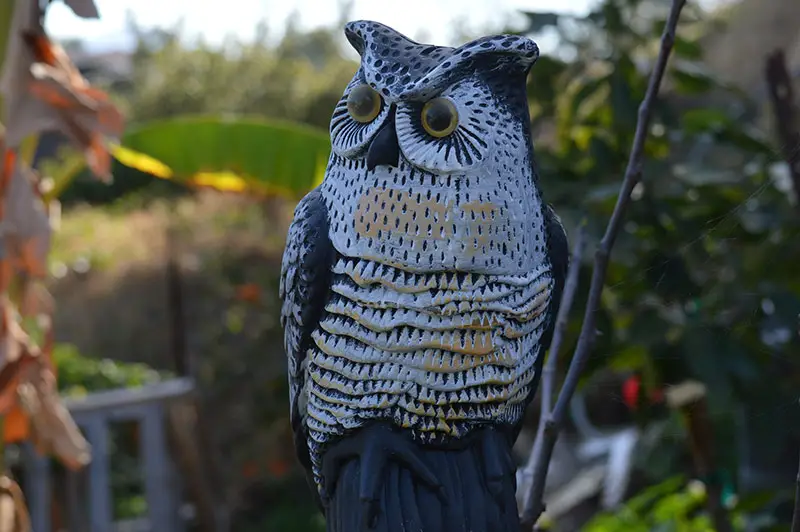
3. Use Bird Deterrents
The final set of options you have to keep birds from eating your grass seed utilize different types of bird deterrents. These are physical, visual, or audible deterrents that will put birds off from coming near your yard and seeding area. As much as ground covers are the most effective method to protect your seeds, bird deterrents further bird-proof your yard; use them in conjunction with a ground cover to protect your grass seed to the fullest degree.
3.1 Use Fake Predators
Following the same logic as to how a scarecrow works, you can keep birds away using fake bird predators. Models of the animals that naturally prey on birds in the wild will trick them into staying away. A decoy owl, hawk, or rubber snake will all work well to keep birds away from your grass seed. There are even some higher-end models that mimic the behavior of the animals using sound and movement mechanisms.
On that thought, the key to using this type of bird deterrent is to mimic the natural behavior of the decoy predator. This means you should place the decoy somewhere it would naturally be, i.e. in a tree as opposed to the center of the lawn. It’s also important to move the decoy every few days; birds have a good memory and will be able to recognize the fake if it sits in one position for too long.
Method: Purchase a decoy owl, hawk, or rubber snake. If birds are eating your grass during the day, choose a fake hawk or snake; this coincides with these predators’ natural hunting habits. If you have issues at night, use an owl instead, as they are naturally nocturnal. Place the decoy somewhere visible in your yard, for instance, in a corner of the lawn or in a tree. Every few days, switch the position of the predator to ensure the birds don’t suspect that it’s fake. Avoid using multiple decoys close together, as this will also indicate to the birds that they’re fake.
3.2 Use Noise Deterrent
Birds are sensitive to sound and typically prefer to spend time and feed in quiet areas. You can use this sensitivity against them by setting up noise deterrents around your yard. There isn’t any specific noise that works to keep birds away, therefore anything that generates any noise will work.
Ultrasonic Sound Deterrents
If you want to set up a noise deterrent that you can’t hear, you can choose an ultrasonic bird repeller. This device emits a high-frequency sound that birds can hear, but isn’t audible to human ears. With that said, there is some debate around how effective these ultrasonic devices are. Many types of songbirds can hear the same frequencies as humans, so if you can’t hear the device, it’s likely they can’t either.
Physical Sound Deterrents
If you can tolerate hearing the noise, there are several different physical objects you can set up that will create an audible deterrent. Wind chimes are an ideal option; they create noise that is pleasant to the human ear but repellant to birds. For a more noisy deterrent, try tying several tin cans or aluminum pans to a post in your yard; they will clang together as the wind blows them, scaring off the birds. You can also use CDs in a similar fashion.
3.3 Use Reflective Surfaces
Most birds are scared of reflective or shiny surfaces and will stay away from them. These work as deterrents as the birds perceive their own reflection as a potential predator and danger to be avoided. On top of this, sunlight reflects off the shiny surfaces which can confuse and disorient the birds. For these reasons, reflective surfaces are effective at deterring the birds without causing them any actual harm.
Mylar tape is great reflective material that will effectively keep birds away from your grass seed. The tape will also make a noise as it moves in the wind, working as both a visual and audible bird deterrent.
3.4 Use Motion-Activated Sprinkler System
Motion-activated sprinklers are a highly effective method to keep birds from eating your grass seed. As soon as the bird comes within range of its sensor, the sprinkler shoots a jet of water in the direction of the motion.
A motion-activated sprinkler system will help to keep a lot of different pests off your lawn, including birds. On top of this, it will keep the lawn consistently watered and will help to conserve energy in the process.
3.5 Set Up Decoy Bird Feeder
Setting up a bird feeder may seem counterintuitive to the advice in this article; although we recommend removing food sources before seeding, this may not be enough to keep birds away from your yard. In this case, you can instead set up a decoy birdfeeder to attract the birds away from your grass seed. Providing the birds with a more tempting source of food nearby means they’re less likely to feed on the seed.
Method: Set up a bird feeder somewhere in your yard elevated away from the planting area. Fill the feeder with nutritious and tasty treats for the birds, such as sunflower seeds, mealworms, peanuts, and fruit. Make sure to always keep the bird feeder well stocked to keep the birds happy and away from your lawn.

